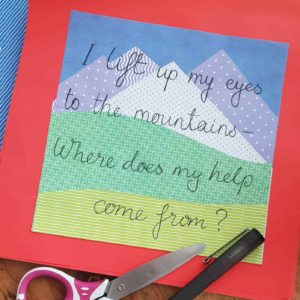 What do you think of when you hear the word multimedia? Do you think a video projector? Lights and smoke? Complex editing suites or mixing desks? In art, multimedia means the artist using more than one fom of art in their work, for example using clay in a painting, or music with a sculpture. Wiki puts it this way:
What do you think of when you hear the word multimedia? Do you think a video projector? Lights and smoke? Complex editing suites or mixing desks? In art, multimedia means the artist using more than one fom of art in their work, for example using clay in a painting, or music with a sculpture. Wiki puts it this way: Multimedia is content that uses a combination of different content forms such as text, audio, images, animations, video and interactive content.
A multimedia Bible exploration sounds like something far too complex for a parent to have time to organise for their home. However, I’d like to propose that it’s not, especially when we use resources others have made.
When helping people work out how to ‘do faith at home’ in their family, I’m always keen to work with them to find ways to make it work in their family (see my article in previous issue #??). However, that doesn’t mean we’re looking for The Thing which will work, as we’re still talking about a family, a group of unique individuals, each on their own journey of faith, with their own preferred way of connecting with God. My solution for this is similar to when I’m planning something intergenerational in a church setting – variety!
Earlier this year I wanted us to focus on a Psalm together, Psalm 121:
I lift up my eyes to the mountains –
where does my help come from?
2 My help comes from the Lord,
the Maker of heaven and earth.
3 He will not let your foot slip –
he who watches over you will not slumber;
4 indeed, he who watches over Israel
will neither slumber nor sleep.
5 The Lord watches over you –
the Lord is your shade at your right hand;
6 the sun will not harm you by day,
nor the moon by night.
7 The Lord will keep you from all harm –
he will watch over your life;
8 the Lord will watch over your coming and going
both now and for evermore.
I was keen for us to learn it, as I learnt lots of Scripture as a child and have found it useful through out my life. However, I wanted it not just to be learnt, but also meditated on and explored a bit. So this is what I did:
1 I created a series of 4 playlists on YouTube (could be anywhere you organise your music), each with two tracks: one with the Psalm being read, one with the Psalm being sung. I tried to stick to the NIV version, as I felt this would be an understandable version to remember and use to life. To be honest, one playlist would have been fine, but the four gave us a bit of variety. By changing the playlist each week, we heard a different voice reading it, which helped us hear it differently, as well as learning different songs of the Psalm. (I tried to pick a wide variety of voices and songs so we could all have at least one we liked.)
We listened to each playlist for one week, once a day, using after breakfast while getting ready to go out, or the first five minutes in the car (before we listened to Lego Movie 2 sound track. Again). I found by doing this fairly consistently three to five days a week, my six and eight year olds learned pretty much all of the words of the Psalm off by heart without even reading it themselves!
2 Week one, I put out a creative activity using squares of origami paper and giant post-its to create collages. I wrote the words of some of the verses out to inspire our pictures. I find creating things like this gives me time to meditate on the words of a particular part of the Psalm. Often the words I choose to collage are those which are resonating with me, so it gives me time to chat with God and think over what they mean for me, and let them settle deeper in my heart. We each did one of these. I would have loved to have made one for each verse, but my daughters weren’t very keen, so I didn’t push it.
3 I recently read that the Psalms could well have been written while God’s people were in exile, and I can see how this Psalm has a different meaning if read in that light. To explore this a little, we watched a few videos about the exile from The Bible Project on YouTube. These are five minute highly visual videos which explore different aspects of the Bible in a lot of detail, very quickly! Even my 6 and 8 year olds liked watching them and understood and remembered some of what we learned about Exile. It was great to watch them and learn together, modelling that we are never too old to learn more about the Bible, and discover more of the treasures God has placed in it for us.
4 It may be coincidence, but when I asked my children what Bible story they’d like to listen to on Biblegateway (you can listen to the whole Bible for free!), they asked for Daniel and Jonah, both books based in a similar time frame to when he Psalm may have been written, and as we listened they spotted overlapping themes in those stories. For example, Jonah prayed to God from inside the big fish – what did he pray? I wonder if he prayed a prayer like Psalm 121? And later, when the Lord makes a plant grow up to shade Jonah from the sun, the Lord is being his shade at his right hand, just like it talks of in Psalm 121.
5 I spent three or four mornings exploring words in the Psalm, using a Hebrew Lexicon app on my phone to explore the wider meaning of the words. I discovered that in the short eight verses of this Psalm, words stemming from the word ‘shamar’ occur five times. It’s a definite theme, so I looked up the meaning of the word shamar, and found that it means to protect, to care for, the preserve, to keep. It’s the word used when it says, “The Lord watches over you (v5) The Lord will keep you from all harm; He watches over your life (v7). The Lord will watch over your coming and going (v8).
Now these are multi-media options which work for me and our family in the season we’re in. They may not be the ways which would work for your family, but I hope they give you some ideas of how you could use different resources to explore a Bible passage in different ways over a period of time like a month.
We are more likely to get some traction with our ideas and resources if they are ones which tap into our family’s preferred styles of connecting with God. This might take a few questions to find out, so try asking yourself and then others in your family the following:
When you last feel connected with God, what was it that helped you connect?
If you could only choose one part of church to help you grow in your faith, what would it be? Sermon? Worship? Fellowship? Creative activities? Games? Quiet space? Opportunity to serve? Something else?
If your family don’t want to chat over some questions, watch them, listen and reflect on these questions:
What are they into? What do they enjoy doing? What patterns in behaviour can you spot?
(For example a child who likes play with Sylvanian families, Play Mobile and makes Lego models to tell stories is into small world play, and might well engage in telling and exploring Bible stories using small world characters.)
What skills are they developing? What interests do they have?
How do they like to connect with God and other people?
If you’d like to read more about different ways people connect with God, I can recommend Carolyn Edward’s excellent book Slugs and Snails and Puppy Dogs Tails, which ostensibly looks like a book about boys and God, but in her research she discovered how we connect with God is more to do with our spiritual styles than our gender – well worth a read!
